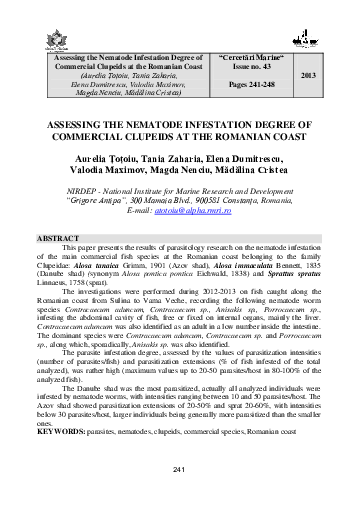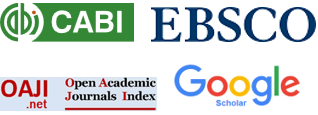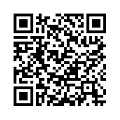Assessing the Nematode Infestation Degree of Commercial Clupeids at the Romanian Coast
DOI:
https://doi.org/10.55268/CM.2013.43.241Keywords:
parasites, nematodes, clupeids, commercial species, Romanian coastAbstract
This paper presents the results of parasitology research on the nematode infestation of the main commercial fish species at the Romanian coast belonging to the family Clupeidae: Alosa tanaica Grimm, 1901 (Azov shad), Alosa immaculata Bennett, 1835 (Danube shad) (synonym Alosa pontica pontica Eichwald, 1838) and Sprattus spratus Linnaeus, 1758 (sprat). The investigations were performed during 2012-2013 on fish caught along the Romanian coast from Sulina to Vama Veche, recording the following nematode worm species Contracaecum aduncum, Contracaecum sp., Anisakis sp., Porrocaecum sp., infesting the abdominal cavity of fish, free or fixed on internal organs, mainly the liver. Contracaecum aduncum was also identified as an adult in a low number inside the intestine. The dominant species were Contracaecum aduncum, Contracaecum sp. and Porrocaecum sp., along which, sporadically, Anisakis sp. was also identified. The parasite infestation degree, assessed by the values of parasitization intensities (number of parasites/fish) and parasitization extensions (% of fish infested of the total analyzed), was rather high (maximum values up to 20-50 parasites/host in 80-100% of the analyzed fish). The Danube shad was the most parasitized, actually all analyzed individuals were infested by nematode worms, with intensities ranging between 10 and 50 parasites/host. The Azov shad showed parasitization extensions of 20-50% and sprat 20-60%, with intensities below 30 parasites/host, larger individuals being generally more parasitized than the smaller Ones
Downloads
Published
2013-12-20
How to Cite
Țoțoiu, A., Zaharia, T., Dumitrescu, E., Maximov, V., Nenciu, M., & Cristea, M. (2013). Assessing the Nematode Infestation Degree of
Commercial Clupeids at the Romanian Coast. Cercetări Marine - Recherches Marines, 43(1), 241–248. https://doi.org/10.55268/CM.2013.43.241
Issue
Section
ORIGINAL ARTICLES
License
This is an open access journal, which means that all content is freely available without charge to the user or his/her institution. Users are allowed to read, download, copy, distribute, print, search, or link to the full texts of the articles, or use them for any other lawful purpose, without asking prior permission from the publisher or the author. This is in accordance with the BOAI definition of open access.






